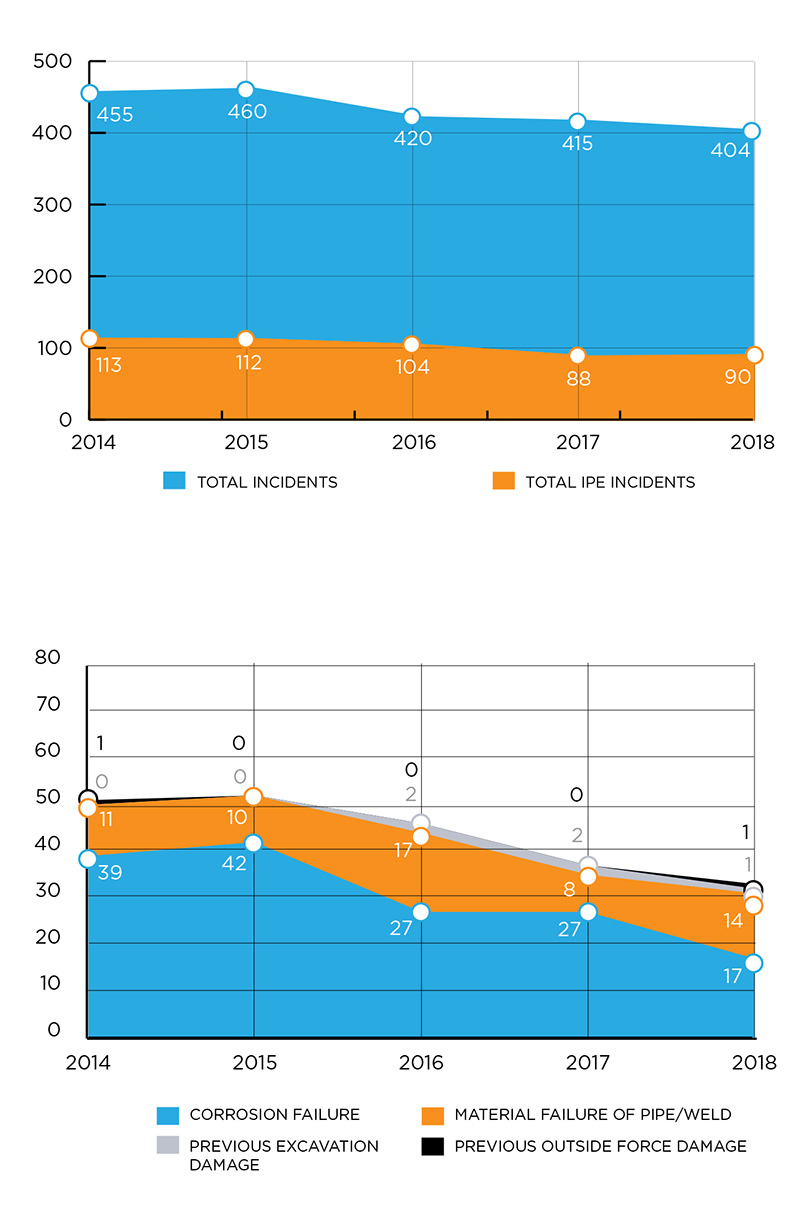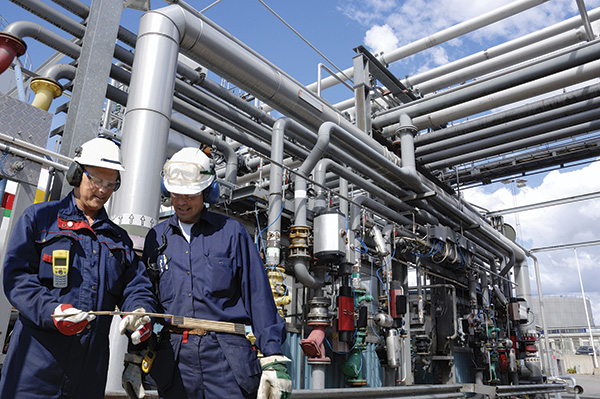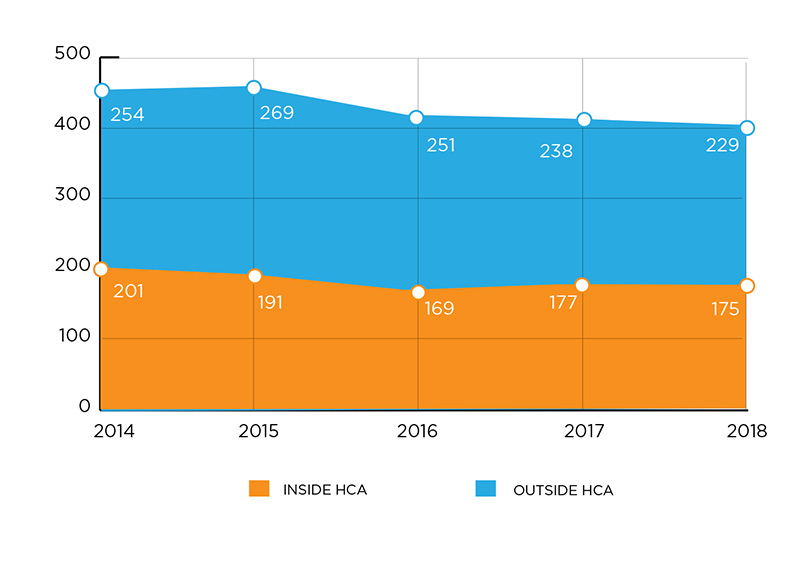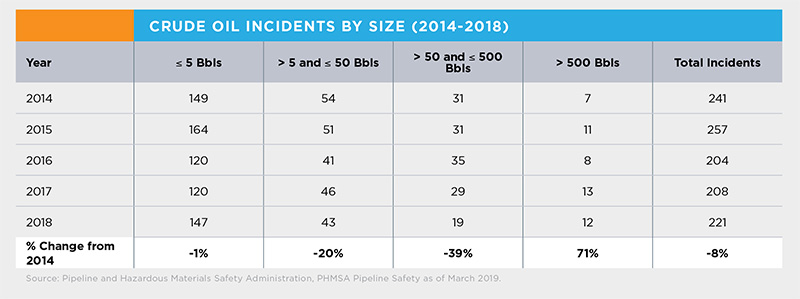January 2020, Vol. 247, No. 1
Features
Pipeline Liquids Safety Record Reflects Inroads, Areas of Concern
By Danielle Wong Moores, Energy Writer
Nearly 98% of barrel miles in the United States are governed by pipeline safety management systems, according to the American Petroleum Institute (API). That, combined with greater public awareness, means that pipeline integrity and safety are under a greater degree of scrutiny than ever before.
Since the incident in Bellingham in 1999 that claimed three lives, the industry and regulators have responded vigorously. API’s Pipeline Safety Excellence Performance 2019 Annual Liquids Report, released in April, highlights some positive news from over the last five years:
- Pipeline incidents impacting people or the environment decreased 20%
- Total pipeline incidents dropped by 11%
- Incidents related to the pipeline itself, such as corrosion, cracking or weld failure, were down 35% in areas impacting people or the environment
- Incidents in public spaces were down by 15%
- Incidents in high-consequence areas were down by 13%
- 74% of pipeline incidents occurred within operators’ own facilities
All of this has occurred even as pipeline mileage and barrels delivered have both increased by 12%.

The downward trend in releases affecting people and the environment is to be applauded. But percentages and actual numbers are two different methods of measurement, and despite some downward movement, when you look at the bigger picture, the actual number of incidents has remained at a mostly flat line over the past several years. Other areas of concern remain.
While most releases are less than 50 barrels (56%), the number of large releases of more than 500 barrels numbered 18 in 2018, nearly doubling from 2014 (10). Equipment failures and corrosion remain the leading reasons for incidents, representing 66% of incidents.
The goal now, say industry leaders, can no longer be to apply a step-change approach. That’s worked well, particularly in the early years after 1999. But operators, organizations and government are making a renewed effort to push through in order to reach zero incidents.
Two areas that could be transformative in the near future are new technologies and public engagement.
“We talk a lot about pipeline safety being a journey,” said Todd Denton, chair of API’s and the Association of Oil Pipe Line’s Pipeline Safety Excellence Committee. “It ‘s going to take some time to get there, but we’re making significant progress.”
Paradigm Shift
API’s report reviews four specific goals that the industry has committed to as part of its push to zero releases:
- Promote organizational excellence
- Improve safety through technology and innovation
- Enhance emergency response preparedness
- Increase stakeholder awareness & involvement
On the ground, Denton, as president of Phillips 66 Pipeline, has seen these goals in action, and his dual roles for his company and API/AOPL give him a unique view. He describes the renewed focus on zero releases as a “paradigm shift.”
“We came up with two categories to accomplish that,” he said. “The first would be around programs” – for example, pipeline SMS and API recommended practices focused on the root causes of failures, such as crack management, water crossings, construction quality and leak detection. “The second piece [is] around technology and data.”
It’s widely known that seams in pipes are prime candidates for corrosion and leaks. But until now, tools have not advanced enough to thoroughly inspect those seams.
In other words, today’s smart pigs are getting smarter. No longer just identifying dents and corrosion, “We are using ultrasonic, electromagnetic acoustic wave, and magnetic flux technologies to find ever-smaller issues in pipelines that we can repair long before they become a problem,” wrote Denton in his message in the API report.
New-tech fiber-optics that run alongside pipelines, satellite monitoring, and drone inspections to inspect safety conditions are also being conducted. Companies too have made a commitment to absorb the higher costs inherent in this process. Even failures offer new opportunities to absorb and apply knowledge.
“[Data analysis] is where things are accelerating really rapidly, by applying machine learning, artificial intelligence – [and] the data is just ramping up exponentially,” said Denton. “We’re talking terabytes of data every time we run one of these tools. … So, when we do see a failure, [we can] analyze that data to put a fingerprint essentially with that and then apply that to existing and future data sets and go repair that [pipe] before it fails. That’s where we going to start seeing the improvement and the drive to zero.”
For example, a pipeline could operate well for 60 or more years, but contain a manufacturing defect in the seam that could result in a leak at some point in time. Phillips 66 saw this happen in one of its pipes where a weld seem had a defect. It ran a crack tool to look for those types of anomalies and made several repairs. Three years later, there was a failure on the pipe, from a crack that the company discovered had “been there from the beginning,” said Denton.
Phillips 66 worked with its vendor and applied the benefit of a detailed failure investigation of three years of new technology and machine learning and AI to perform a data analysis. When they reran the same smart tool from three years prior, they uncovered 20 more areas that needed attention.
“[That was] because of what we learned from that failure and better data analysis three years after that tool was run,” said Denton. “Potentially that saves another release or more.”
Eliminating Releases
At the same time, the strategy underpinning these new technologies and opportunities remains the same: Work on eliminating very large releases and those in high-consequence areas.
At Phillips 66, files on every foot of pipe outline worst-case discharges – part of the company’s mitigation analysis and practices. On large-diameter pipes, which can involve large releases if pipes leak, one strategy for example is close automatically in the event of a leak, fewer barrels escape.
Meanwhile, the Pipeline and Hazardous Materials Safety Administration has until recently mandated only that operators of hazardous liquid pipelines run tools in high-consequence areas and conduct those reviews every five years. Roughly 45% of the industry’s pipes flow through these HCAs.
However, PHMSA recently published a final rule, effective July 1, 2020, extending reporting requirements to certain hazardous liquid gravity and rural gathering lines; requiring inspection of lines affected by extreme weather and natural disasters; requiring integrity assessments at least every 10 years for onshore hazardous liquid pipeline segments located outside of HCAs that are able to accommodate in-line inspection; extending the required use of leak detection systems beyond HCAS to all regulated, non-gathering hazardous liquid pipelines; and requiring that all pipelines in or affecting HCAs be able to accommodate ILI within 20 years; among others.
The new rule takes into account congressional mandates dating back to 2011. While some may see that as another example of the snail’s pace of regulatory policy development, work doesn’t stop while regulations are being developed. According to API and Denton, 95% of liquid pipes are inspected by industry at least once every five years, some every three years, and some annually.
In this way, industry can get ahead of regulations, even as they speak with regulators about rules ahead on the horizon and work in tandem on research and development to further improve pipeline safety.
Bringing regulations up to date has the advantage of helping to drive further industry research and development to advance technology in leak detection, according to API.
“The vast majority of time, industry is moving faster than the regulations can adjust,” said Robin Rorick, vice president of Midstream & Industry Operations at API. “So, it’s really making sure that we’re not relying on the regulation to drive change improvements, that industry is moving as quickly as they can here implementing technologies as soon as they are practical, and we are able.”
Denton concurs, stressing clear communications is essential.
“We want to be as transparent as possible with them and vice versa because it goes back to being collaborative,” he said. “We have good relationships with the folks at PHMSA. We talk a lot about where they can do some things to drive improvement within the industry. We want to have the right minimum standards out there – and there are a lot of companies that go above and beyond those minimum standards. We want to make sure we’re generally raising the bar and that are focused on the right things. …We both have the same goal of getting to zero releases.”
Rise of Activism
Likewise, for the public, any release is too much. Major incidents – both in liquid and gas pipelines – over the past few years have led to a rise of environmental activism against new pipeline development along with, on the gas side, a wave of cities banning natural gas in new construction.
At the same time, the industry is grappling with a public that may have little to no knowledge of pipeline infrastructure, other than when a disaster happens.
“There’s almost 3 million miles of gathering and distribution and transmission lines,” said Rorick. “[Yet] there is largely an unawareness there of pipelines and the importance of pipelines and even the need for greater pipeline infrastructure development because of the onset of the oil and gas revolution. If they’re unaware of pipelines, it stands to reason they’re also unaware of the safety commitments that industry has made and the regulatory requirements that are placed upon the industry as well. This is where the industry is really trying to turn a corner.”
Whether or not the public has listened, public awareness has long been a regulatory requirement and a best practice. But as part of the push to zero, the industry is focused on a new buzzword: engagement, designed to be a two-way conversation to better understand where the public is when it comes to understanding risk and safety implications of pipelines and having an overall better awareness of pipelines.
API is working on a three-year plan with AOPL that incorporates public engagement and is also discussing a potential recommended practice on engagement. It has already begun the work by conducting workshops and identifying strategic priorities.
“We recognize as an industry it takes one incident and all that good work is really pushed aside,” said Dave Murk, pipeline manager at API. “As operators, our goal is zero incidents and we really truly believe that…We heard it from our regulator, Skip Elliott [PHMSA administrator], who said the industry does have a very good safety record, but you have .001% you still have to address. How are we doing that, what are those innovative ways that we’re looking at it, what are those transformational things that we’re doing as an industry? And we’ve taken that to heart.”
Rorick points to the data highlighted beginning on Page 25 of API/AOPL’s report.
“We’re very proud of it, and we also use it as a launching point on how we move forward. This isn’t lip service and it’s not a talking point,” he said. “This really is used by the industry to figure out where we go next.”
At API, six policy groups are consistently reviewing data and reporting on key issues on a quarterly basis, considering whether there’s a need to update a recommended practice, issue a bulletin or share information via quarterly virtual “tailgates” that typically attract a couple hundred people sitting in on the call. The tailgates allow operators to talk about an incident or a near miss to help guide other operators who might come up against a similar situation.
One key metric, Rorick said, is the incidents impacting people or the environment. “That’s important for us, in the sense of understanding where the public’s concerns are, really homing in on that … what’s causing those incidents and looking at it from a strategic standpoint how to address those.”
How the engagement piece will look in the future and what practices API might recommend are still to be developed, but the goal, everyone agrees, is for that two-way conversation to exist. “We’re listening,” said Denton.
It will take that – along with an all-of-above approach – to reach zero defects. But Denton believes strongly that it is possible: At Phillips 66, “we will deliver approximately 1 billion barrels through 12,000 miles of pipe over the course of the year,” he said. “In 2019, we’ve had three corrosion-related integrity releases on our pipelines in remote areas with no impact in water. Three is not far from zero.”








Comments